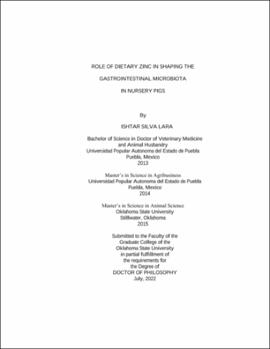| dc.contributor.advisor | Carter, Scott D. | |
| dc.contributor.author | Silva Lara, Ishtar | |
| dc.date.accessioned | 2023-04-05T16:21:19Z | |
| dc.date.available | 2023-04-05T16:21:19Z | |
| dc.date.issued | 2022-07 | |
| dc.identifier.uri | https://hdl.handle.net/11244/337323 | |
| dc.description.abstract | Gut microbiota play an important role in extraction, synthesis and absorption of nutrients. Commensal bacteria prevent pathogenic bacteria colonization and maintain intestinal epithelium integrity. The most common families of commensal bacteria in nursery pigs are Prevotellaceae, Clostridiaceae, Erysipelotrichaceae, Lachnospiraceae, Lactobacillaceae, Ruminicoccaceae and Streptoccocaceae. Understanding the microbial abundance shifts that causes health disruption leading to diarrhea and stunted growth performance can be of great benefit for developing mitigation strategies. Next generation sequencing (NGS) technology facilitates metagenomic approaches, developing sequencing profiles representing any and all organisms within a sample. Electronic-probe Diagnostic Nucleic acid Analysis (EDNA) is a bioinformatic tool originally developed to detect species-specific plant pathogen targets in metagenomic databases. EDNA has been shown to reduce time to detect microbial signatures in large metagenomic sequence data. However, it has not previously been used as a metagenomic tool for assessing microbiome composition at the family level. Therefore, E-probes for detection of gut microbiota of the seven most common commensal families were developed. The hits were able to detect the relative abundance variations of the 4-time periods. The current study confirms the importance of bacterial taxa influencing growth and diarrhea, although data are conflicting in some cases. Nonetheless, as demonstrated by the E-probes, specific bacterial taxa are consistently associated with growth performance in the nursery phase. In conclusion, the growth performance and diarrhea-associated bacterial taxa identified in this research could potentially be used to identify microbiota changes promptly that could lead to health impairment and economic impact on pig production. Overall, the approach outlined here can reduce the time to detect microbiota changes essential for determining a pig's health status, decreasing the side effects of unhealthy animals in the swine production. | |
| dc.format | application/pdf | |
| dc.language | en_US | |
| dc.rights | Copyright is held by the author who has granted the Oklahoma State University Library the non-exclusive right to share this material in its institutional repository. Contact Digital Library Services at lib-dls@okstate.edu or 405-744-9161 for the permission policy on the use, reproduction or distribution of this material. | |
| dc.title | Role of dietary zinc in shaping the gastrointestinal microbiota in nursery pigs | |
| dc.contributor.committeeMember | DeSilva, Udaya | |
| dc.contributor.committeeMember | Espindola Camacho, Andres | |
| dc.contributor.committeeMember | Cardwell, Kitty F. | |
| osu.filename | silvalara_okstate_0664d_17844.pdf | |
| osu.accesstype | Open Access | |
| dc.type.genre | Dissertation | |
| dc.type.material | Text | |
| thesis.degree.discipline | Animal Science | |
| thesis.degree.grantor | Oklahoma State University | |
